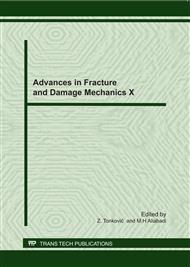p.411
p.416
p.420
p.424
p.428
p.432
p.436
p.440
p.444
Slow Crack Growth by Grain Boundary Dissolution of Hydroxyapatite in Water
Abstract:
Mechanical degradation of hydroxyapatite ceramics due to the slow crack growth was observed in water. Microstructural crack on the surface of hydroxyapatite initiated by grain boundary dissolution in liquid environment resulting in particle loosening and microstructural-level degradation, followed by a drastic decrease of mechanical properties. In this study, slow crack growth by the dissolution behavior of hydroxyapatite ceramics was investigated based on microstructural observation by field emission microscopy. The crack growth and morphological change of hydroxyapatite surface, especially at the initial stage of dissolution and related surface roughness were observed with immersion time. The surface dissolution occurred from the initial stage of immersion showing increase in surface roughness. Following certain period of immersion time, the surface dissolution initiated at grain boundaries and generated many separated grains.
Info:
Periodical:
Pages:
428-431
Citation:
Online since:
September 2011
Authors:
Price:
Сopyright:
© 2012 Trans Tech Publications Ltd. All Rights Reserved
Share:
Citation:


